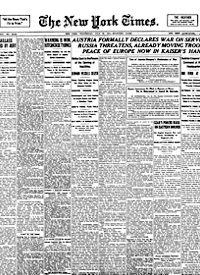
If anyone has been trying to pin the blame on rightwing Republicans for creating a “climate of hate” that supposedly led to the January 8 shooting in Tucson, it hasn’t been the New York Times. That’s what the Times says, anyway, in a “news analysis” it published Tuesday.
The Times noted negative reaction from “conservative politicians who bridled at suggestions in the media that Jared Loughner might have been influenced by right-wing rhetoric and talk radio…” Not to mention the now infamous map that former vice presidential candidate and current Fox News commentator Sarah Palin published on the Internet, targeting with crosshairs congressional districts where Democratic candidates might be defeated. One of those districts was the one represented by Gabrielle Giffords, who was apparently the gunman’s target in the shooting rampage that killed six people and left Rep. Giffords and more than a dozen others wounded.
Reacting to charges that she was in some way responsible for the carnage, Palin fired back (ooops! Make that “replied”) that journalists and pundits should not engage in a “blood libel that serves only to incite the very hatred and violence that they purport to condemn.”
“The question left unanswered,” said the Times, is “which journalists and pundits”? While the shooting was widely reported and discussed in the print and broadcast media, “most of the direct accusations against conservative talk radio and pundits were leveled by people online, not members of the mainstream media,” the Times said. The news analysis took issue with Fox News talk show host Bill O’Reilly, who blamed the Times and other “merchants of hate” for portraying people on the right as, in effect, “accessories to murder.” O’Reilly cited as evidence a Times editorial and a column by Paul Krugman, one of the paper’s regular op ed commentators.
“The Times editorial did not actually blame the right for Mr. Loughner’s actions, saying, ‘It is facile and mistaken to attribute this particular madman’s act directly to Republicans or Tea Party members,'” the news analysis said, noting that O’Reilly did not read that portion of the editorial. Rather, he focused on the following sentence: “But it is legitimate to hold Republicans and particularly their most virulent supporters in the media responsible for the gale of anger” to which the Times attributes an increase in the number of threats made against judges and members of Congress.
But the Times editorial, published the day after the shooting, went beyond that, claiming,
Many on the right have exploited the arguments of division, reaping political power by demonizing immigrants, or welfare recipients, or bureaucrats…. Now, having seen first hand the horror of political violence, Arizona should lead the nation in quieting the voices of intolerance, demanding an end to the temptations of bloodshed, and imposing sensible controls on its instruments.
Meaning more controls on gun ownership, of course.
How, in the absence of any but the most speculative of ideas about the shooter’s motive, was the Times able to characterize the shooting as “political violence”? The newspaper, with its uncanny skill for long-distance psychoanalysis, noted the man arrested and accused of the crime “appears to be mentally ill. His paranoid ravings about government and mind control place him well beyond usual ideological categories.” What thoughts he has, if any, about immigrants, welfare recipients or bureaucrats are yet unknown, yet the Times implies he was motivated to deadly violence by the demonizing of such persons by “[m]any on the right,” including “the Republicans and particularly their most virulent supporters in the media….”
Just who is being demonized and how? Does criticizing government welfare programs, many of which perpetuate poverty and dependence, make demons of the recipients? Is opposition to illegal immigration, an issue that should unite all who respect the rule of law, a demonizing of immigrants? Who among us has not at one time or another railed against the asinine procedures or seemingly incurable stupidity of one or more of our growing legion of bureaucracies? Does that amount to a violent hatred of bureaucrats? The way the Times describes it, you might think we were all there holding the gun at that Tucson shopping center.
The Krugman column, which also appeared in the Times the day after the shooting, took a more direct and candid aim at the right. He asked,
Where’s that toxic rhetoric coming from? Let’s not make a false pretense of balance: it’s coming, overwhelmingly, from the right. It’s hard to imagine a Democratic member of Congress urging constituents to be “armed and dangerous” without being ostracized; but Representative Michele Bachmann, who did just that, is a rising star in the G.O.P.
Krugman also described a “huge contrast” between the left and the right in the media. “Listen to Rachel Maddow or Keith Olbermann and you’ll hear a lot of caustic remarks and mockery aimed at Republicans. But you won’t hear jokes about shooting government officials or beheading a journalist at the Washington Post. Listen to Glenn Beck or Bill O’Reilly and you will.”
I rarely listen to any of them, so I can’t attest to either the truth or falsehood of Krugman’s characterizations. But the aforementioned Keith Olbermann does not necessarily train his “caustic remarks and mockery” only at Republicans, though the GOP undoubtedly gets the overwhelming majority of it. When Hillary Clinton was running for President, Olbermann suggested on his MSNBC program that the Democrats’ best solution for her candidacy might be “Somebody who can take her into a room and only he comes out.”
On the night of the Arizona shooting, Olbermann went before the MSNBC cameras and apologized for that “clumsy metaphor” that “sounded as if it was [sic] a call to physical violence.” (Imagine that! Keith Olbermann sounding violent.) But not before he excoriated “those politicians and commentators who have so irresponsibly brought us to this time of domestic terrorism,” namely Sarah Palin, Sharron Angle, Glenn Beck, Bill O’Reilly and others.
Jay Nordlinger at National Review recently offered some examples of rhetorical excesses from the left that more than hinted at physical violence, even assassination. They include CBS talk-show host Craig Kilburn’s showing in 2000 of then-candidate George W. Bush on screen, along with the words “SNIPERS WANTED.” In 2006, New York comptroller Alan Hevesi, addressing graduating students at Queens College said Sen. Charles Schumer would “put a bullet between the president’s eyes if he could get away with it.”
Wall Street Journal columnist James Taranto offered yet another example. Last October, Paul Kanjorski of Pennsylvania, then a Democratic member of Congress, had some choice words to say about Rick Scott, a candidate for governor of Florida. “Instead of running for governor of Florida, they ought to have him and shoot him,” Kanjorski said. “Put him up against the wall and shoot him.” Kanjorski was defeated for reelection the following month, but he hasn’t completely disappeared. Last week he was deploring the violence in Arizona — on the op ed page of the New York Times.
“We all lose an element of freedom when security considerations distance public officials from the people,” Kanjorski wrote. “Therefore, it is incumbent on all Americans to create an atmosphere of civility and respect in which political discourse can flow freely, without fear of violent confrontation.”
No doubt the “atmosphere of civility and respect” is best served when the New York Times and other organs of the “mainstream media” shield us from what Krugman called that “pretense of balance” that might otherwise require them to condemn violent rhetoric on the left as well as the right.



